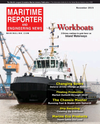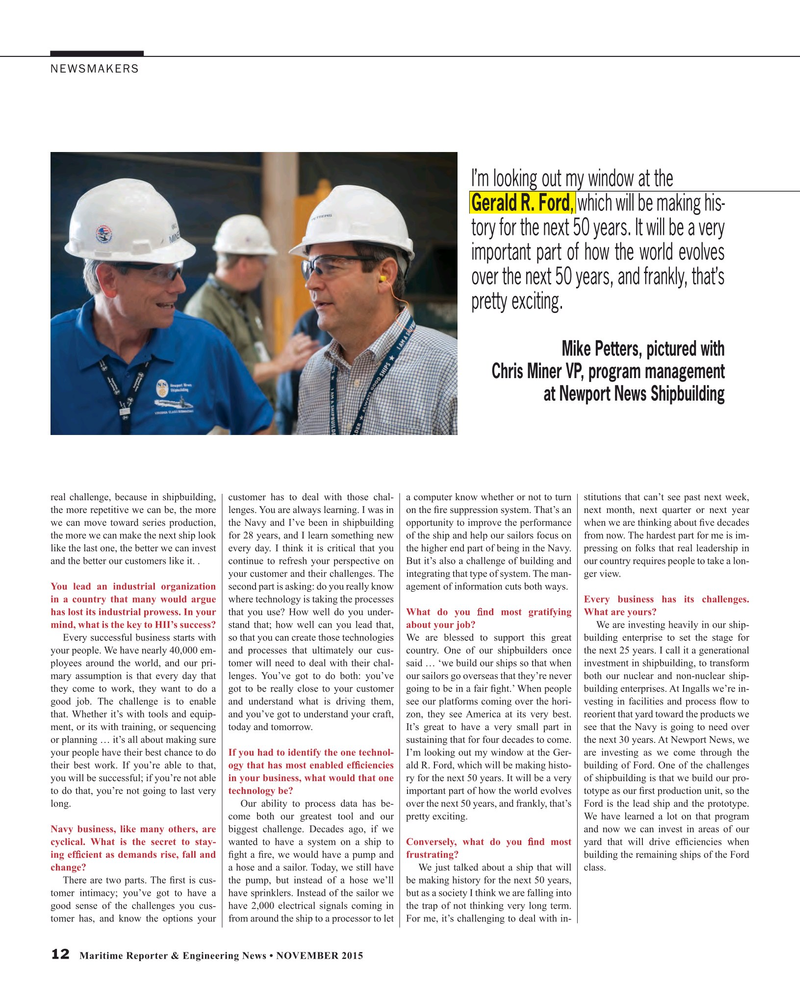
Page 12: of Maritime Reporter Magazine (November 2015)
Workboat Edition
Read this page in Pdf, Flash or Html5 edition of November 2015 Maritime Reporter Magazine
NEWSMAKERS
I’m looking out my window at the
Gerald R. Ford, which will be making his- tory for the next 50 years. It will be a very important part of how the world evolves over the next 50 years, and frankly, that’s pretty exciting.
Mike Petters, pictured with
Chris Miner VP, program management at Newport News Shipbuilding real challenge, because in shipbuilding, customer has to deal with those chal- a computer know whether or not to turn stitutions that can’t see past next week, the more repetitive we can be, the more lenges. You are always learning. I was in on the ? re suppression system. That’s an next month, next quarter or next year we can move toward series production, the Navy and I’ve been in shipbuilding opportunity to improve the performance when we are thinking about ? ve decades the more we can make the next ship look for 28 years, and I learn something new of the ship and help our sailors focus on from now. The hardest part for me is im- like the last one, the better we can invest every day. I think it is critical that you the higher end part of being in the Navy. pressing on folks that real leadership in and the better our customers like it. . continue to refresh your perspective on But it’s also a challenge of building and our country requires people to take a lon- your customer and their challenges. The integrating that type of system. The man- ger view.
You lead an industrial organization second part is asking: do you really know agement of information cuts both ways.
in a country that many would argue where technology is taking the processes Every business has its challenges. has lost its industrial prowess. In your that you use? How well do you under- What do you ? nd most gratifying What are yours?
mind, what is the key to HII’s success? stand that; how well can you lead that, about your job? We are investing heavily in our ship- Every successful business starts with so that you can create those technologies We are blessed to support this great building enterprise to set the stage for your people. We have nearly 40,000 em- and processes that ultimately our cus- country. One of our shipbuilders once the next 25 years. I call it a generational ployees around the world, and our pri- tomer will need to deal with their chal- said … ‘we build our ships so that when investment in shipbuilding, to transform mary assumption is that every day that lenges. You’ve got to do both: you’ve our sailors go overseas that they’re never both our nuclear and non-nuclear ship- they come to work, they want to do a got to be really close to your customer going to be in a fair ? ght.’ When people building enterprises. At Ingalls we’re in- good job. The challenge is to enable and understand what is driving them, see our platforms coming over the hori- vesting in facilities and process ? ow to that. Whether it’s with tools and equip- and you’ve got to understand your craft, zon, they see America at its very best. reorient that yard toward the products we ment, or its with training, or sequencing today and tomorrow. It’s great to have a very small part in see that the Navy is going to need over or planning … it’s all about making sure sustaining that for four decades to come. the next 30 years. At Newport News, we your people have their best chance to do If you had to identify the one technol- I’m looking out my window at the Ger- are investing as we come through the their best work. If you’re able to that, ogy that has most enabled ef? ciencies ald R. Ford, which will be making histo- building of Ford. One of the challenges you will be successful; if you’re not able in your business, what would that one ry for the next 50 years. It will be a very of shipbuilding is that we build our pro- to do that, you’re not going to last very technology be? important part of how the world evolves totype as our ? rst production unit, so the long. Our ability to process data has be- over the next 50 years, and frankly, that’s Ford is the lead ship and the prototype. come both our greatest tool and our pretty exciting. We have learned a lot on that program
Navy business, like many others, are biggest challenge. Decades ago, if we and now we can invest in areas of our cyclical. What is the secret to stay- wanted to have a system on a ship to Conversely, what do you ? nd most yard that will drive ef? ciencies when ing ef? cient as demands rise, fall and ? ght a ? re, we would have a pump and frustrating? building the remaining ships of the Ford change? a hose and a sailor. Today, we still have We just talked about a ship that will class.
There are two parts. The ? rst is cus- the pump, but instead of a hose we’ll be making history for the next 50 years, tomer intimacy; you’ve got to have a have sprinklers. Instead of the sailor we but as a society I think we are falling into good sense of the challenges you cus- have 2,000 electrical signals coming in the trap of not thinking very long term. tomer has, and know the options your from around the ship to a processor to let For me, it’s challenging to deal with in- 12 Maritime Reporter & Engineering News • NOVEMBER 2015
MR #11 (10-17).indd 12 10/30/2015 10:17:59 AM

 11
11

 13
13
